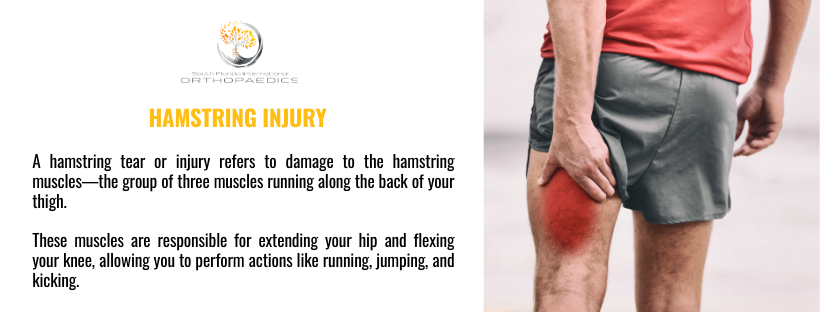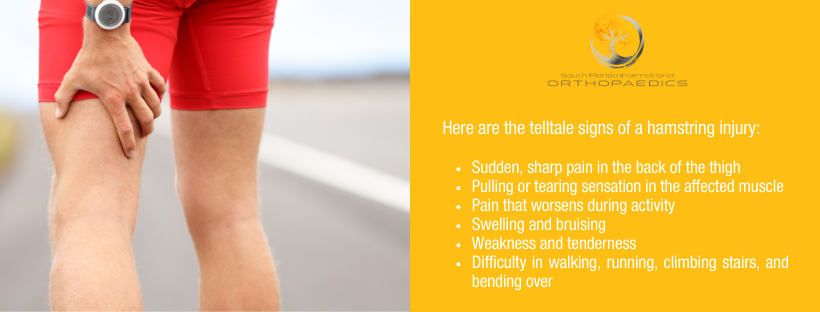Have you ever been running at full speed only to feel a sharp pain shoot up the back of your thigh, forcing you to hobble to a stop? That pain you are feeling is likely a hamstring injury.
The hamstrings are the powerful muscles that run along the back of your thigh. They are crucial for activities like running, jumping, and kicking.

However, these hard working muscles are also susceptible to strain and tears, especially for athletes and anyone who enjoys activities that involve explosive movements.
Head on below to learn all about hamstring injuries—its signs, causes, and how you can expertly navigate the road to recovery.
What are hamstring injuries?
A hamstring tear or injury refers to damage to the hamstring muscles—the three muscles running along the back of your thigh. These muscles are responsible for extending your hip and flexing your knee, allowing you to run, jump, and kick.
Hamstring injuries can range from mild to severe, depending on the extent of the damage to the muscle fibers. Here’s a breakdown of the severity:
- Strain: This is the most common type of hamstring injury. It involves a microscopic tearing of the muscle fibers, often described as a “pulled muscle.”
- Partial tear: In a partial tear, a greater number of muscle fibers are torn, but the muscle remains intact.
- Complete tear: A complete tear is the most severe type of hamstring injury. In this case, the muscle is completely ruptured, and you may experience a popping sensation during injury.
What causes hamstring injuries?
Hamstring injuries typically occur due to sudden, forceful contractions of the muscles. They can also happen when the muscles are stretched beyond their capacity. Here are some common culprits:
Sudden changes in direction
Activities like sprinting, cutting sharply, or jumping can put immense stress on the hamstrings, especially if the muscles are tight or not properly warmed up.
Improper exercise technique
Squatting with a rounded back, running on uneven terrain, or using poor form during lunges can put undue strain on the hamstrings.
Muscle tightness and inflexibility
Tight hamstrings are more prone to tears when they are forced to stretch rapidly.
Overuse and repetitive strain
Repetitive activities that involve forceful hamstring contractions—without adequate rest and recovery—can lead to micro-tears and eventual injury.
Lack of proper warm-up and cool-down
A cold muscle is a stiff muscle, and stiff muscles are more susceptible to injury. Taking the time to warm up your hamstrings before exercise and cool down afterward increases blood flow and prepares the muscles for activity.
How do I know if I have a hamstring injury?
The severity of a hamstring injury can range from a mild strain to a complete tear. Here’s how to identify the telltale signs:
- Sudden, sharp pain in the back of the thigh
- Pulling or tearing sensation in the affected muscle
- Pain that worsens during activity
- Swelling and bruising
- Weakness and tenderness
- Difficulty in walking, running, climbing stairs, and bending over
It’s important to note that the severity of the pain doesn’t always reflect the extent of the injury. A seemingly minor strain can sometimes be a more serious tear.
If you experience any of these symptoms, especially if the pain is severe or doesn’t improve within a few days, it’s crucial to consult a doctor for proper diagnosis and treatment.
How is it diagnosed?
Diagnosing a hamstring injury typically involves a two-pronged approach: a physical examination by a doctor and potentially imaging tests for a more definitive picture. Imaging tests may include X-rays, ultrasound, and MRI.

These two approaches allow your doctor to accurately diagnose your hamstring injury and recommend the most appropriate treatment plan.
What are the treatment options for a hamstring injury?
The treatment for a hamstring injury depends on the severity of the tear. Here’s a breakdown of the most common approaches:
Non-surgical treatment
The good news is that most mild to moderate hamstring injuries heal with proper care. Here’s what you can expect:
- RICE method: The acronym RICE stands for Rest, Ice, Compression, and Elevation. This is the cornerstone of treatment for most soft tissue injuries, including hamstring strains.
- Pain medication and anti-inflammatory drugs (NSAIDs): Over-the-counter pain relievers like ibuprofen or acetaminophen can help manage pain and inflammation.
- Physical therapy: A physical therapist can design a personalized rehabilitation program that includes the following:
- Stretching exercises to improve flexibility
- Strengthening exercises to rebuild muscle strength
- Massage to promote healing
Surgery
A complete tear is the most serious type of hamstring injury and often requires a more aggressive approach to treatment.
In some cases, surgery may be necessary to reattach the torn muscle tendon to the bone. Following surgery, a comprehensive physical therapy program is essential for regaining strength and flexibility and returning to full function.
Heal Your Stride at South Florida International Orthopaedics
Whether you’re a weekend warrior or a competitive athlete, a nagging hamstring strain or a sudden tear can leave you frustrated and wondering where to turn.

At South Florida International Orthopaedics, we understand the importance of getting you back on your feet, pain-free, and ready to move with confidence.
Our team of highly-rated orthopedic surgeons boasts extensive experience diagnosing and treating a wide range of orthopedic conditions, including hamstring injuries of all severities.
Our Miami orthopedics specialists stay at the forefront of medical advancements in sports medicine in Miami and orthopedic surgery in Miami, FL.
With multiple locations conveniently situated throughout Miami and Homestead, we make getting the expert care you need easy and accessible.
Contact us today to book a consultation.
The material contained on this site is for informational purposes only and DOES NOT CONSTITUTE THE PROVIDING OF MEDICAL ADVICE, and is not intended to be a substitute for independent professional medical judgment, advice, diagnosis, or treatment. Always seek the advice of your physician or other qualified healthcare providers with any questions or concerns you may have regarding your health.
